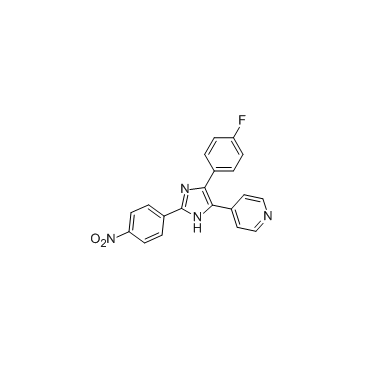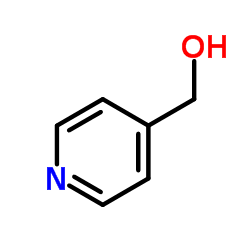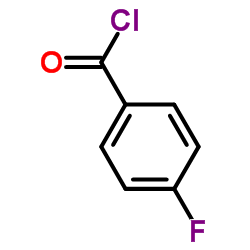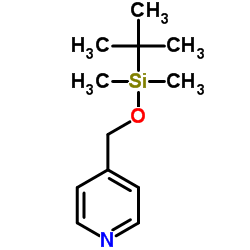152121-53-4
| Name | 4-[4-(4-fluorophenyl)-2-(4-nitrophenyl)-1H-imidazol-5-yl]pyridine |
|---|---|
| Synonyms |
4-[4-(4-Fluorophenyl)-2-(4-nitrophenyl)-1H-imidazol-5-yl]pyridine
4-(4-Fluorophenyl)-2-(4-nitrophenyl)-5-(4-pyridyl)-1H-imidazole PD169316 PD 169316 |
| Description | PD 169316 is a potent, cell-permeable and selective p38 MAP kinase inhibitor, with IC50 of 89 nM. |
|---|---|
| Related Catalog | |
| Target |
IC50: 89 nM (p38 MAPK)[5] |
| In Vitro | PD169316 (10 μM) inhibits TGFβ and Activin A, but not BMP4 signaling in CaOV3 cells. PD169316 (0.2-20 μM) inhibits TGFβ-induced Smad2 nuclear translocation, Smad7 mRNA induction, and reporter gene activity in CaOV3 cells[1]. PD169316 (10 μM) shows a significantly increased rate of proliferation in Nestin knockdown cells, and can rescue the effect of Nestin knockdown on cell viability in the absence of EGF[2]. PD169316 significantly inhibits p38 MAP kinase activity with no significant change in ERK activity in PC12 cells. PD169316 (10 μM) blocks apoptosis induced by trophic factor withdrawal in differentiated PC12 cells[3]. |
| In Vivo | PD169316 (30 ng/5 μL) or in combination with U0126 improves spatial learning in MWM in Aβ-injected rats, 20 days after Aβ-injection. Pretreatment with U0126 and PD169316 decreases the levels of phosphorylated form of ERK and p38 to about 77.7 and 64.2%, respectively, and causes a significant increase in c-fos, p-CREB, NRF-1 and TFAM protein levels, compared to the Aβ-injected group[4]. |
| Kinase Assay | Sixteen hours after the removal of serum from Rat-1 fibroblasts or NGF from differentiated PC12 cells, the cells are incubated in the absence or presence of insulin (50 ng/mL) for 15 min at 37°C. After washing with 2 mL of ice-cold PBS, the cells are solubilized in 400 μL of ice-cold immunoprecipitation buffer containing 10 mM Tris, pH 7.4, 1% Triton X-100, 0.5% Nonidet P-40, 150 mM NaCl, 1 mM EDTA, 1 mM EGTA, 0.2 mM sodium orthovanadate, and 0.2 mM phenylmethylsulfonyl fluoride. The cell lysates are centrifuged to remove insoluble material, and 200 μg of the supernatant protein (400 μL, total volume) are incubated with 1 μg of anti-p38 antibodies for 1 h at 4°C followed by incubation with 30 μL of Protein G Plus/Protein A-agarose for an additional hour. The immunocomplexes are pelleted and washed twice in immunoprecipitation buffer and then once in kinase ish buffer (50 mM β-glycerolphosphate, 1 mM EGTA, 20 mM MgCl2, 100 μM sodium orthovanadate). The protein kinase assay is initiated by the addition of 20 μL of 2× reaction buffer (50 mMβ-glycerolphosphate, 1 mM EGTA, 20 mM MgCl2, 100 μM sodium orthovanadate, 0.1 mg/mL ATF-2 (N-terminal half), 50 μg/mL IP20, a peptide inhibitor of c-AMP dependent protein kinase, 200 μM ATP, and 0.9 mCi/mL [32P]ATP) to 20 μL of immune complex. The reaction is allowed to proceed for 10 min at 30°C and then terminated by the addition of 2× LaemmLi sample buffer and analyzed by SDS-polyacrylamide gel electrophoresis using 12% acrylamide gels. After electrophoresis, the gels are dried and subjected to phosphoimaging. |
| Animal Admin | Adult male albino Wistar rats weighing 210-280 g are used in these experiments. Animals are divided into six groups: (A) Aβ-injected group, which receives bilateral intra-CA1 injection of Aβ (30 ng/3 μL PBS per side), 4 h after unilateral i.c.v. administration of DMSO (5 μL/rat), without receiving any treatment; (B) vehicle group, which only receives carrier, DMSO in lateral ventricle and PBS (3 μL/side) in both CA1 regions; (C) ERK inhibitor group, which receives i.c.v. infusion of U0126 (30 μg/5 μL 1% DMSO in PBS) with PBS injection (3 μL/side in CA1); (D) p38 inhibitor group, which receives i.c.v. infusion of PD169316 (30 μg/5 μL 1% DMSO in PBS) with PBS injection (3 μL/side in CA1); and (E) treatment group which receives i.c.v. administration of U0126 (30 μg/5 μL 1% DMSO in PBS), 4 h prior to intra-hippocampal A (30 ng/3 μL PBS per side) injection; (F) treatment group which receives i.c.v. administration of PD169316 (30 μg/5 μL 1% DMSO in PBS), 4 h prior to intra-hippocampal A (30 ng/3 μL PBS per side) injection. The aforementioned groups enter two experimental protocols: behavioral experiments and molecular studies. All the groups of animals in molecular study are considered as 7 and 20-day experimental groups. |
| References |
| Density | 1.4±0.1 g/cm3 |
|---|---|
| Boiling Point | 583.1±50.0 °C at 760 mmHg |
| Molecular Formula | C20H13FN4O2 |
| Molecular Weight | 360.341 |
| Flash Point | 306.4±30.1 °C |
| Exact Mass | 360.102264 |
| PSA | 87.39000 |
| LogP | 5.32 |
| Appearance | yellow solid |
| Vapour Pressure | 0.0±1.6 mmHg at 25°C |
| Index of Refraction | 1.651 |
| Storage condition | -20℃ |
| Symbol |


GHS05, GHS06 |
|---|---|
| Signal Word | Danger |
| Hazard Statements | H301-H315-H318-H335 |
| Precautionary Statements | P261-P280-P301 + P310-P305 + P351 + P338 |
| Personal Protective Equipment | dust mask type N95 (US);Eyeshields;Faceshields;Gloves |
| Hazard Codes | Xn |
| Risk Phrases | 22-37/38-41 |
| Safety Phrases | 26-39 |
| RIDADR | UN 2811 6.1/PG 3 |
| Precursor 6 | |
|---|---|
| DownStream 0 | |






